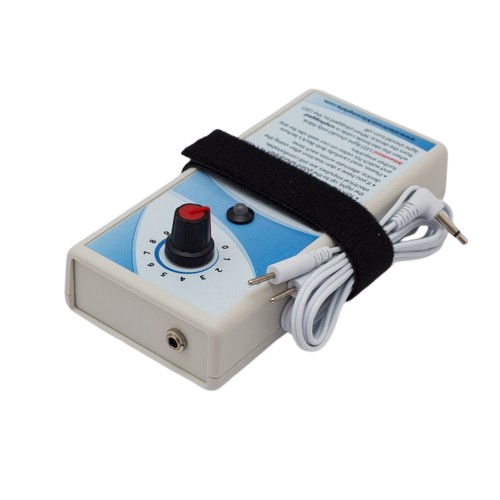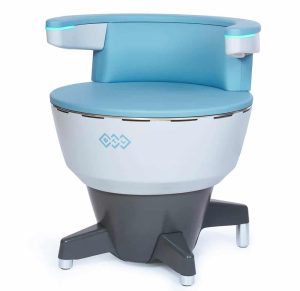EMS for People Who Pee Too Easily: How Electric Muscle Stimulation Helps Rebuild Control
For many, stress urinary incontinence (SUI)—the type of bladder leakage that happens during activities like laughing, sneezing, or exercising—can be a quiet frustration. The muscles responsible for holding things in just don’t seem to work the way they should. For some, Kegel exercises don’t seem to help, or it’s tough to even tell if they’re doing them right. That’s where Electrical Muscle Stimulation (EMS) comes in.
EMS (Electrical Muscle Stimulation) is a powerful, non-invasive tool that helps activate and strengthen the pelvic floor muscles, which can improve control over bladder leaks. Instead of guessing whether those muscles are engaging during Kegels, EMS uses gentle electrical pulses to trigger them directly. These pulses effectively “wake up” the muscles, training them to work better over time.
How EMS Works
EMS devices use electrical currents to stimulate the pelvic floor muscles, causing them to contract and strengthen. The beauty of EMS is that it does the work for you, meaning people who struggle with muscle engagement don’t have to rely on simply trying to “feel” a contraction. It’s a bit like a workout for the pelvic floor, but without having to think too hard about it.
At-Home EMS Devices vs In-Clinic Options
1. At-Home EMS Devices
These are small, user-friendly gadgets designed for private use. Typically, they come with a small internal probe (which can be inserted vaginally or anally) to deliver electrical pulses directly to the pelvic floor muscles. Users can sit comfortably while the device does its job.
Sessions last about 15–20 minutes, and most people use them a few times a week. With consistent use, many people report improvements in muscle strength, bladder control, and a decrease in leaks.
Some of the most popular at-home devices include:
- Elvie Trainer
- Neen Pericalm
- Kegel8 Ultra 20
- TensCare
These devices are often recommended for those who want to take control of their pelvic health at home, with full privacy and ease.
2. In-Clinic EMS Therapy
For those seeking professional guidance or dealing with more severe cases, clinical EMS therapy might be a better option. Pelvic floor physical therapists use specialized, powerful EMS machines to target deep pelvic muscles with greater precision.
Additionally, biofeedback might be used, allowing patients to see their muscle contractions on a screen, making it easier to understand how to engage the muscles correctly. Clinic sessions are typically weekly or bi-weekly, and many patients also receive education on how to continue EMS therapy at home.
Emsella: The EMS Chair
For those who prefer a non-invasive, hands-free option, EMS chairs like Emsella are a game-changer. Emsella is a high-tech chair designed specifically for pelvic floor strengthening, especially for people with stress urinary incontinence.
Emsella Chair
What makes Emsella different?
It’s a fully clothed, non-invasive treatment that uses High-Intensity Focused Electromagnetic (HIFEM) energy to stimulate deep pelvic floor muscles. The device causes thousands of contractions in a 30-minute session—essentially doing the equivalent of 11,000 Kegels. It’s ideal for those who don’t want to deal with probes or invasive treatments but still want the benefits of electrical stimulation.
Emsella works by having you sit in the chair during the session, fully clothed, and it provides a deeply effective workout for your pelvic floor muscles. Most people need 6–8 sessions for lasting results, but it’s a great option for those seeking a more public or clinic-based solution.
Does EMS Work?
The good news is, EMS can be very effective, with many users reporting better muscle tone, fewer leaks, and improved bladder control. Just like any muscle-building activity, results take time and consistency, but many find it’s a useful addition to their pelvic health routine. EMS can also complement Kegels by enhancing the strength and awareness of the pelvic floor muscles.
Why Choose EMS?
For those who struggle with urinary leaks or pelvic floor weakness, EMS offers a targeted, reliable solution. Whether using an at-home device, seeing a pelvic health therapist in the clinic, or sitting in an Emsella chair, it’s an empowering way to regain control over your body—without the guesswork. Plus, it can work well for people who struggle with internal devices or want a more comfortable, private option.
By using EMS to strengthen the pelvic floor, people can improve their bladder control, stop leaks from interfering with their day-to-day life, and boost confidence in both their pelvic health and their social activities.
If you’re dealing with frequent leaks and Kegels haven’t worked, EMS might just be the answer you need—whether it’s a home device or an in-clinic treatment like Emsella.
This material reflects personal research conducted in my spare time and is intended for informational purposes only. It does not constitute medical advice. Always consult a qualified healthcare provider.

